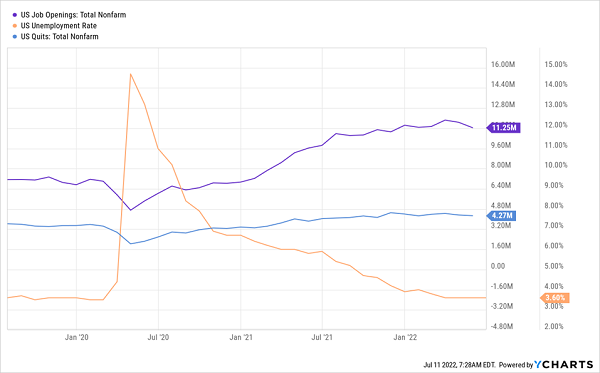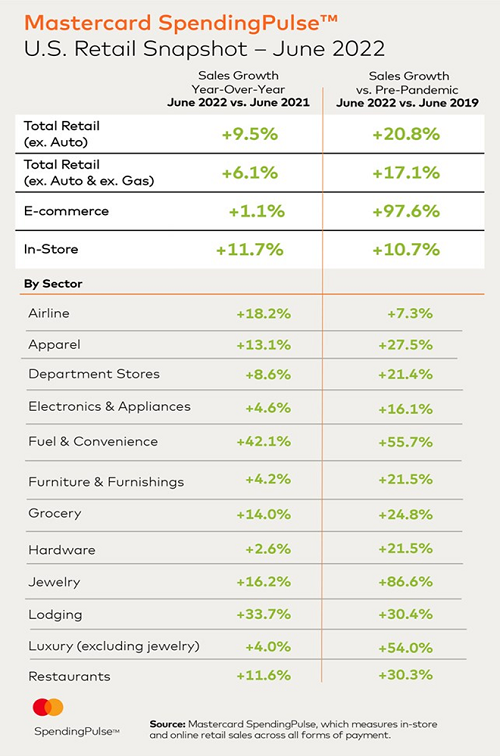If you’re like me, you’re getting sick of this tug-of-war between inflation and recession worries. One steals our purchasing power, while the other knocks down our portfolio values!
But I’ve got good news for you—two pieces of good news, actually.
- Our closed-end funds (CEFs) continue to deliver high, and reliable, income. The portfolio of my CEF Insider service boasts many funds yielding north of 8%, and the vast majority pay dividends monthly. Those high yields help us hedge against inflation, and the extra dividend cash (should we let it build up in our portfolios) naturally reduces our volatility.
- Recession fears are overblown, according to the latest data (which we’ll get to in a bit). That makes now a good time to buy high-yielding stock-focused CEFs.
Let’s look at why this opportunity exists. Further on, we’ll discuss a cornerstone CEF that’s paying an incredible 11% dividend. It’s a nice pickup now, to get in position for when some of the dark news priced into stocks today fails to come to pass and equities take off, as I expect.
Jobs Up, Unemployment Down

Take a close look at the chart above. First, we can see that job openings and quits (in purple and blue, respectively) continue to rise, with over 50% more job openings now than there were pre-pandemic. This indicates that corporate America is desperate for more workers to fill consumer demand (which is soaring, too; see below).
At the same time, the rise in quits is significant because it shows that workers are confident they can get a new job, which I think you’ll agree is something that does not happen in recessions.
Sometimes job openings do stay high in bad economic times (the early 2010s was a good example), which is why the second key point on the chart above is crucial: the unemployment rate (in orange) is at a historically low 3%, and it’s staying low. There are just too many jobs and employers desperate for workers—again, not things that happen in a recession!
Companies, of course, don’t hire out of the goodness of their hearts; they do so to fulfill demand from customers. High job openings and low unemployment thus mean high consumer demand.

Mastercard (MA) knows Americans’ spending habits, and the company’s latest data shows a big rise in outlays across the board—even compared to before the pandemic. Spending is up a whopping 30% at restaurants and 17% in total retail sales, excluding automobiles and gas.
Before you say that this is the result of inflation, consider that these numbers are higher than the inflation rate, so we can’t say it’s just rising prices driving the extra spending. No, it’s consumers spending more money because they have more income, thanks to the strong job market.
Why Stocks Are Down
Of course, despite all this, stocks have had a terrible year—and that, of course, is mainly due to fear that the Fed, desperate to catch up after letting inflation run hot for too long, will overdo it on rate hikes and tip the country into a recession.
This has terrified markets, because the last time the Fed raised rates this aggressively was just ahead of the 2008/’09 financial crisis. Back then, higher rates popped the housing bubble and sent stocks—and the economy—into a deep contraction.
Stocks didn’t sell off before that recession hit, meaning there was a lot of room to fall when the recession was in full force. Investors remember that pain, and they’ve been trying to get ahead of it by selling off over the last few months.
This Is not 2008—Recession Worries Are Already Baked In
This brings me to the good news: the pain seems mostly behind us. Unlike in 2008, the market has already priced in a recession, which is why stock declines have slowed significantly and we’ve stayed off the bottom for a month now.
The Worst Priced In?

With a bear market already accounted for, stocks are prepared for slower economic growth, a decline in employment and consumer belt tightening—all things that haven’t happened yet, and may not happen at all.
An 11%-Yielding CEF That’s Primed for a Market Rebound
All of this means that stocks are set to rise on any good news (or even on any less-bad news), and the strong economic numbers we just covered suggest that this is what will happen. That makes the 11%-yielding CEF I mentioned a second ago, the Liberty All-Star Equity Fund (USA), worth paying attention to right now.
USA Beats the Market, Returns Your Profits in Cash??

Not only does USA yield 11%, but it’s beaten the broader index over the last five years while holding many of the same companies: firms like Amazon (AMZN), Visa (V), Salesforce (CRM) and PayPal (PYPL). These are exactly the firms that are in line to benefit from Americans spending more. And that’s why USA is worth your attention now.
Go With These Monthly Paying CEFs (Yielding 7.9%) for Ultimate Stability
The only drawbacks with USA are that it pays dividends quarterly, and its payout flexes with its portfolio value.
That’s no problem if you don’t need dividends now, but if you draw a regular income stream from your portfolio, you’d be better off with the 5 monthly paying CEFs (yielding 7.9%) that I recommend in an exclusive Special Report you can download right here.
These 5 CEFs are the perfect buys for this panicked market, providing steady, predictable monthly dividends that roll in right alongside your bills. Plus, all five are deeply discounted now, priming them for extra gains in the coming market bounce.
Don’t miss this opportunity. Click here and I’ll tell you all about my CEF-investing strategy and show you how to download your in-depth Special Report containing the names, tickers, dividend yields and all the other vitals on these 5 stout income funds.
